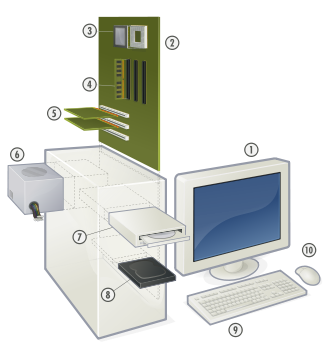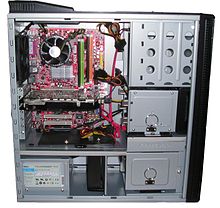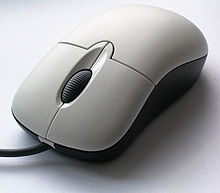- Personal computer hardware
-
 Hardware of a modern personal computer
Hardware of a modern personal computer
1. Monitor
2. Motherboard
3. CPU
4. RAM
5. Expansion cards
6. Power supply
7. Optical disc drive
8. Hard disk drive
9. Keyboard
10. MousePersonal computer hardware are component devices which are typically installed into or peripheral to a computer case to create a personal computer upon which system software is installed including a firmware interface such as a BIOS and an operating system which supports application software that performs the operator's desired functions. Operating systems usually communicate with devices through hardware buses by using software device drivers.
Contents
Mother board
Main article: MotherboardThe motherboard is the main component inside the case. It is a large rectangular board with integrated circuitry that connects the other parts of the computer including the CPU, the RAM, the disk drives (CD, DVD, hard disk, or any others) as well as any peripherals connected via the ports or the expansion slots.
Components directly attached to the motherboard include:
- The central processing unit (CPU) performs most of the calculations which enable a computer to function, and is sometimes referred to as the "brain" of the computer. It is usually cooled by a heat sink and fan. Newer CPUs include an on-die Graphics Processing Unit (GPU).
- The chip set mediates communication between the CPU and the other components of the system, including main memory.
- RAM (random-access memory) stores resident part of the current running OS (OS core and so on) and all running processes (application parts, using CPU or input/output (I/O) channels or waiting for CPU or I/O channels).
- The BIOS includes boot firmware and power management. The Basic Input Output System tasks are handled by operating system drivers. Newer motherboards use Unified Extensible Firmware Interface instead of BIOS.
- Internal buses connect the CPU to various internal components and to expansion cards for graphics and sound.
- Current
- The north bridge memory controller, for RAM and PCI Express
- PCI Express, for expansion cards such as graphics and physics processors, and high-end network interfaces
- PCI, for other expansion cards
- SATA, for disk drives
- ATA
- The north bridge memory controller, for RAM and PCI Express
- Obsolete
- Current
- External bus controllers support ports for external peripherals. These ports may be controlled directly by the south bridge I/O controller or based on expansion cards attached to the motherboard through the PCI bus.
Power supply
Main article: Power supply unit (computer)A power supply unit (PSU) converts alternating current (AC) electric power to low-voltage DC power for the internal components of the computer. Some power supplies have a switch to change between 230 V and 115 V. Other models have automatic sensors that switch input voltage automatically, or are able to accept any voltage between those limits. Power supply units used in computers are nearly always switch mode power supplies (SMPS). The SMPS provides regulated direct current power at the several voltages required by the motherboard and accessories such as disk drives and cooling fans.
Removable media devices
Main article: Computer storage- CD (compact disc) - the most common type of removable media, suitable for music and data.
- CD-ROM Drive - a device used for reading data from a CD.
- CD Writer - a device used for both reading and writing data to and from a CD.
- DVD (digital versatile disc) - a popular type of removable media that is the same dimensions as a CD but stores up to 12 times as much information. It is the most common way of transferring digital video, and is popular for data storage.
- DVD-ROM Drive - a device used for reading data from a DVD.
- DVD Writer - a device used for both reading and writing data to and from a DVD.
- DVD-RAM Drive - a device used for rapid writing and reading of data from a special type of DVD.
- Blu-ray Disc - a high-density optical disc format for data and high-definition video. Can store 70 times as much information as a CD.
- BD-ROM Drive - a device used for reading data from a Blu-ray disc.
- BD Writer - a device used for both reading and writing data to and from a Blu-ray disc.
- HD DVD - a discontinued competitor to the Blu-ray format.
- Floppy disk - an outdated storage device consisting of a thin disk of a flexible magnetic storage medium. Floppies are used today mainly for loading device drivers not included with an operating system release (for example, RAID drivers).
- Iomega Zip drive - an outdated medium-capacity removable disk storage system, first introduced by Iomega in 1994.
- USB flash drive - a flash memory data storage device integrated with a USB interface, typically small, lightweight, removable, and rewritable. Capacities vary, from hundreds of megabytes (in the same range as CDs) to tens of gigabytes (surpassing, at great expense, Blu-ray discs).
- Tape drive - a device that reads and writes data on a magnetic tape, used for long term storage and backups.
Secondary storage
Hardware that keeps data inside the computer for later use and remains persistent even when the computer has no power.
- Hard disk - for medium-term storage of data.
- Solid-state drive - a device similar to hard disk, but containing no moving parts and stores data in a digital format.
- RAID array controller - a device to manage several internal or external hard disks and optionally some peripherals in order to achieve performance or reliability improvement in what is called a RAID array.
Sound card
Main article: Sound cardEnables the computer to output sound to audio devices, as well as accept input from a microphone. Most modern computers have sound cards built-in to the motherboard, though it is common for a user to install a separate sound card as an upgrade. Most sound cards, either built-in or added, have surround sound capabilities.
Input and output peripherals
Main article: PeripheralInput and output devices are typically housed externally to the main computer chassis. The following are either standard or very common to many computer systems.
Input
Main article: Input device- Text input devices
- Keyboard - a device to input text and characters by depressing buttons (referred to as keys or buttons).
- Pointing devices
- Mouse - a pointing device that detects two dimensional motion relative to its supporting surface.
- Optical Mouse - uses light (laser technology) to determine mouse motion.
- Trackball - a pointing device consisting of an exposed protruding ball housed in a socket that detects rotation about two axes.
- Touchscreen - senses the user pressing directly on the monitor.
- Mouse - a pointing device that detects two dimensional motion relative to its supporting surface.
- Gaming devices
- Joystick - a hand-operated pivoted stick whose position is transmitted to the computer.
- Game pad - a hand held game controller that relies on the digits (especially thumbs) to provide input.
- Game controller - a specific type of controller specialized for certain gaming purposes.
- Image, Video input devices
- Image scanner - a device that provides input by analyzing images, printed text, handwriting, or an object.
- Web cam - a video camera used to provide visual input that can be easily transferred over the internet.
- Audio input devices
- Microphone - an acoustic sensor that provides input by converting sound into electrical signals.
Output
Main article: Output device- Printer - a device that produces a permanent human-readable text of graphic document.
- Dot Matrix Printer
- Laser Printer
- Ciode display
- OLED - Organic Light-Emitting Diode
- Monitors
See also
- Glossary of computers
References
Basic computer components Input devices Keyboard · Image scanner · Microphone · Pointing device (Graphics tablet · Joystick · Light pen · Mouse · Touchpad · Touchscreen · Trackball) · Webcam (Softcam)Output devices Removable data storage Computer case Central processing unit (CPU) · Hard disk / Solid-state drive · Motherboard · Network interface controller · Power supply · Random-access memory (RAM) · Sound card · Video cardData ports Ethernet · Firewire (IEEE 1394) · Parallel port · Serial port · Thunderbolt · Universal Serial Bus (USB)Categories:- Personal computers
- Computer hardware
- Personal computing
Wikimedia Foundation. 2010.


